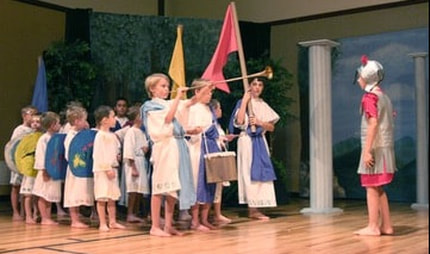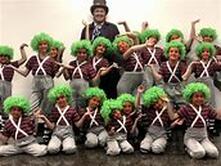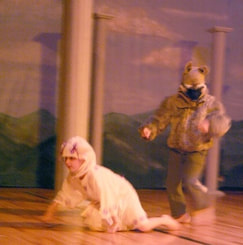
Playing acting games is a great way to teach skills to young actors. Children may not understand the difference between real and make-believe. There are so many skills that can be taught by playing acting games, but start with just a few main types. Experimenting with role playing, working with props, and exploring the stage can really help them learn the basics of acting and to differentiate between real and make-believe.
Role-Playing - The director will explain a situation to two children. It could go something like this: "You and your friend are on the playground playing with a ball. Suddenly the ball goes flat. What would you do?" The children then act out what they would do in that situation. The children can silently act or pantomime the situation, or they can use words and props. This type of acting game is the beginning of learning improvisation.
Working with Props - Learning to handle props can be a coordination nightmare for little children. Best to keep the actions very simple and the rules of use very clear. It can be fun, occasionally, to let the children handle a random prop and imagine an alternate use for it. For example, the director will assemble an array of household items such as a hairbrush, a hand-broom, a ladle, a feather duster, an empty spray bottle, wooden salad forks, a sock, and cinch sack. Put them in a container and let the children take turns pulling out one item and determine how to demonstrate their alternate use for it. Explain that there are no wrong moves and it is all for fun. You may even have the rest of the group guess what the actor is demonstrating. The actor can always set the group straight if they guess unsuccessfully.
Exploring the stage - Young actors need to get familiar with all parts of the stage. They need to know how to get on and off, how the curtains work, where the "line of death" is (the front edge of the stage that they must never go near!), and any other physical particulars. They need to become familiar with stage directions so that the director can easily block their places. They need to learn the rules for negotiating around scenery.
Using simple games can help them learn about these things and more in fun and interesting ways.
STAGE DIRECTIONS GAME: First explain the main stage directions UP, DOWN, CENTER, STAGE LEFT, and STAGE RIGHT. Then have the children line up in small groups. Tell the children that each group will pretend to be a different type of animal as they move "in character" to the area directed. You may ask the butterfly group to flit delicately across the stage to DOWN RIGHT. You may ask the elephants to lumber to UP CENTER. You may ask the monkeys to bounce over to DOWN LEFT. And the snakes should slither to DOWN CENTER.
Once they reach their destination, they FREEZE. The director then asks the groups to listen for their next destinations and on the signal they MOVE again. This can be repeated as often as desired. The groups can also change their identities to liven it up. Keep this game SIMPLE and SHORT!!!!
* * * * * * * *
The picture above is from "Never Cry Wolf" where the Military Academy boys are learning to march. These actors painted their own shields just like the ancient Greek warriors would have done.




 RSS Feed
RSS Feed